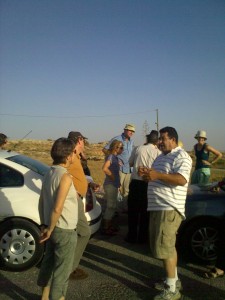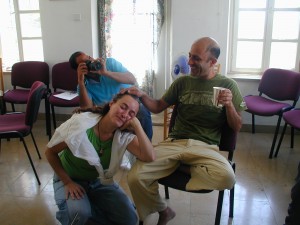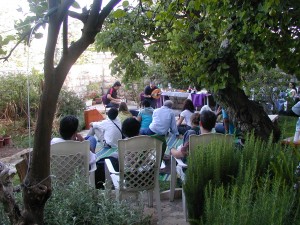Prepare Jerusalem for peace now – an Article
We just published an article at the Jerusalem Post and Search for Common Ground (SFCG) News service, focusing on the need for preparing today Jerusalem for potential peace scenarios. Here are the links and the text:
Text:
Prepare Jerusalem for peace now
June 26, 2010By HAGAI AGMON-SNIR
Last month, a Home Front Command exercise was carried out in Israel. The emergency systems were tested for their response to various scenarios in case war breaks out. That same week, someone jokingly disseminated a message on the Internet regarding an emergency exercise that would be carried out to test responses for when peace breaks out. In this imaginary exercise, calming sirens would be sounded and the general public would be required to respond to the cheerful scenarios that may unfold in this new and unfamiliar situation.
In Jerusalem, the idea of preparing for peace should not be a topic of jokes. We are so preoccupied with the struggle over what the city would look like following a permanent status agreement that we are ignoring the fact that present-day Jerusalem is declining before our eyes, becoming a city in which life would be difficult even when peace finally arrives.
In east Jerusalem, Palestinian children suffer from a severely underfunded public education system. As a result, most will not find employment that can afford any kind of social mobility.
Health issues – such as development checkups – are often neglected, and health problems that should be addressed in childhood will become a future economic and social burden, even in times of peace.
Chaos in the material aspects of life is sorely evident in east Jerusalem, where things like dense construction around roads which preempt any future expansion and collapsing sewage systems are creating an irreversible reality on the ground. The poverty and neglect in east Jerusalem will not only cause hardship for the Palestinians living there but will also affect the Jews in west Jerusalem whether the city remains united or divided, because if the city remains united, the need to rectify these problems would affect the funding for the western neighborhoods; if it is divided, poverty and neglect in the east would quickly become fertile ground for crime and terror against the Jews in the west of the city.
In west Jerusalem, the nonharedi Jewish population is dwindling. The city does not attract an economically strong population or young people who are not haredim, as there a few job opportunities. It remains very attractive to the haredim for religious reasons, but they are economically weak. The deterioration of west Jerusalem is bad news for everyone: A Jerusalem that is home to large populations that are economically weak will be a miserable city for all those still left in it.
DESPITE ALL these threats to the future of the city, too often Jerusalem’s municipal decision-making process is shaped by considerations that contradict local interests and cater to global politics. One example is Jewish construction beyond the Green Line. The construction in Ramat Shlomo in north Jerusalem and in Gilo in the south made headlines across the world. Yet, anyone who has taken part in Israeli- Palestinian negotiations on Jerusalem knows that in any reasonable scenario, these neighborhoods will remain on the Israeli side. Moreover the construction in these neighborhoods is of high importance to the Jewish sector in the city, since construction for haredim in the north and for non- Orthodox in the south decreases the need for the haredi population to move into the secular neighborhoods in southern Jerusalem.
Reducing this pressure would strengthen west Jerusalem and this in turn, would benefit the residents in the east. Whether Jerusalem is united or divided, economic and employment cooperation between the two parts of the city keeps them intertwined and interdependent.
However, as Israel refuses to differentiate between legitimizing the building in Gilo and legitimizing the settling in the heart of the Palestinian neighborhoods, the Palestinians and the rest of the world do not make this distinction either. The world hears about Jews who enter homes in the Sheikh Jarrah neighborhood after its Palestinian inhabitants are evicted. The result: worldwide political pressure to stop the construction in Gilo and Ramat Shlomo, the same construction that can contribute to the prosperity of the city.
Israel, in response, toughens its stance on Palestinian construction in Silwan. This brings only harm to all the residents of Jerusalem Almost 800,000 people live in Jerusalem, from a variety of religions, nationalities, religious outlooks and ethnic groups. When peace comes this diversity can turn into a wonderful resource for anyone who is interested in visiting or living in Jerusalem – if only we could save the city from its current decline.
For this to happen the decision-making process on the municipal level must shift to a professionalism dedicated to improving services for all the residents of the city, one that sets aside global considerations. A greater focus on these issues at the municipal level will make Jerusalem friendlier to its inhabitants. And paradoxically, focusing on its own population’s needs can help turn Jerusalem, even in the eyes of the world, from a political burden into a universal resource.
The writer is the director of the Jerusalem Intercultural Center and can be reached at hagai@jicc.org.il. This article is published in conjunction with the Common Ground News Service and forms part of a special series on Jerusalem.




